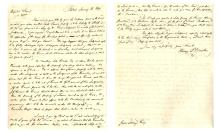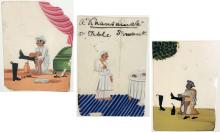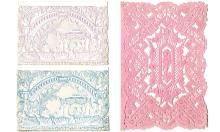This month’s Artifact of the Month is an edition of the Port Hole newspaper from November 1, 1944. This semi-monthly journal was published by the American Red Cross Service Club and printed by Sands & McDougall Pty. Ltd. in Australia for the sailors stationed in the Pacific Theater of World War II. There are numerous articles including two opinion pieces on Navy Day, reports on sports and local events, and notices and schedules of social events.
This month’s Artifact of the Month is a woodblock designed by Kate Faulkner in the late 1800s (#1989.2118). The block consists of three layers of one-inch-wide wood planks laminated with nails and screws. The top layer is carved around the edges and there are outlines of a floral pattern made of brass and copper wire along with felt.
This month’s featured Artifact of the Month is a Costa Rican two-colón note from 1941 (1993.003.033).
This month’s Artifact of the Month features a map of ancient Asia Minor made by the W. & A.K. Johnston firm in the mid to late 1800s. The map shows the historical regions of Armenia Maior, Mesopotamia, and Babylonia, among others. There is a note in pencil along the edge of the sheet indicating 1897 as a possible date of publication, but further research has yielded another date of 1877 based on the atlas published by the firm in that year as well as the fact that the cartographer, Keith Johnston, passed away before 1897.
This month’s Artifact of the Month is an artist book from 1985 made by Ruth Laxson (2021.10.010). Laxson’s book is folded like an accordion and is comprised of six panels on an off-white paper with a neatly torn edge. The subject of these panels is a landscape of yellow, blue, purple, pink, and green scribbles and torn, adhered paper from which red strings sprout. In the upper third of the middle panels, flying blue and red hummingbirds have been stamped.
This month’s featured Artifact of the Month is a letter written by Henry Sandwith Drinker to Jason Torrey, Esq. (1988.394). This letter, dated January 18, 1819, concerns the sale, taxes, and levies on properties in Bethany, Pennsylvania. Drinker was replying to a previous letter from his friend, Torrey, in which he had asked about the properties that had been confiscated by the courts and were to be sold shortly. Drinker was a lawyer and merchant in Philadelphia born into a prominent Quaker family to Henry Drinker and Elizabeth Sandwith Drinker.
This month’s Artifact of the Month is eleven spiral-bound notebooks filled with Chinese paper cuts (#2014.002.001-011). These notebooks are covered in decorative paper and hold over twenty paper cuts per notebook, each with a backing of index card. The subjects range from multi-color dragons to highly detailed horses. Chinese paper cuts are called jiǎnzhǐ and serve many different traditional purposes, including decoration for homes or festivals in addition to tools for religious rites.
This month’s Artifact of the Month is a collection of Indian mica paintings (A#1993.005.641.A-O). These fifteen 19th century paintings were created by Indian artists during the colonial period for the Anglo-American souvenir market. Along with other local art, they were so popular amongst government officials, merchants, and missionaries that they came to be known as “Company Paintings” collectively.










